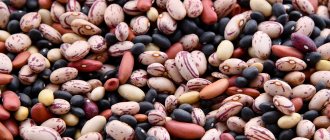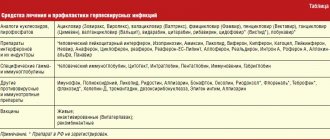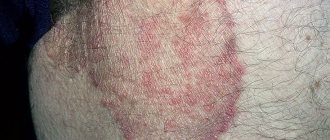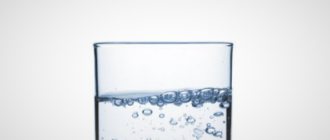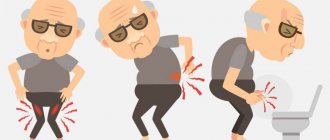Flatulence is a common condition in adults. According to statistics, at least 40% of people who consult a gastroenterologist complain of constant increased gas formation, and up to 100% of people have experienced it at least once in their lives. In the absence of diseases of the gastrointestinal tract, flatulence in adults does not pose a serious threat to health, but it significantly reduces the quality of life and causes a lot of inconvenience.
There are three sources of gas in the intestines:
- air swallowed during eating, talking, smoking;
- formation of gases in the intestinal lumen, including production by intestinal bacteria;
- gases entering the intestines from the blood.
Normally, about 200 ml of gas is present in the gastrointestinal tract at a time. During the day, more than 20 liters are formed, and most of the gases are destroyed and absorbed through the intestinal walls. The exceptions are nitrogen and hydrogen sulfide - they are removed only through the rectum. With flatulence, the volume of gas becomes larger, which causes serious discomfort to the person.
Causes of increased gas formation
Excessive gas formation can be due to a variety of reasons. One of them is the imperfection of the enzyme system or disruption of its function, which is more typical for children in the first days of life. Researchers Yazenok and Zhelnova (Yazenok N.S., Zhelnova T.I., Bondarenko N.V., Novokshenova T.P., Kirsanova A.I., 2003, p. 16). In this case, the following causes of flatulence are distinguished:
- unbalanced diet;
- diseases of the upper gastrointestinal tract: duodenitis, gastritis;
- diseases of the liver and gall bladder: hepatitis of any origin, cholecystitis, etc.
Other mechanisms for the development of the disease include imbalances in the microflora of the colon. With them, carbohydrates and proteins that come with food are not completely absorbed by the mucous membrane. Normally, dietary fiber from fruits and vegetables, especially legumes and coarse-fiber fruits, is broken down by intestinal bacteria. The result of their vital activity is the formation of a large volume of gases. A significant portion of gases is absorbed by aerobic intestinal bacteria. And with dysbacteriosis, the balance between bacteria producing and consuming gases is disrupted. However, it is important to remember that even in the absence of microflora imbalance, a special diet can cause the formation and release of large amounts of gases. A diet based on foods rich in cellulose and beans can cause flatulence. Other products that increase gas formation include soda, lamb meat, as well as products in which fermentation and fermentation processes are already occurring, for example, kvass.
Another mechanism for the development of flatulence is intestinal distension due to paresis. This is due to abdominal surgeries performed. In this case, the cause of flatulence in adults is the very fact of the intervention. After it, intestinal motility slows down, and this leads to fermentation and putrefactive processes. The condition is accompanied by spasmodic pain because gases accumulate in the intestinal lumen.
A common cause of increased gas formation is emotional stress, nervous disorders and shocks. The mechanism of development of this syndrome is explained by spasm of smooth muscles, including the intestines, and a slowdown in peristalsis.
Gastrointestinal motility stimulants
A New Year's diet, replete with fatty, spicy and salty foods, can increase the production of the neuropeptide hormone cholecystokinin [4], which inhibits the motor-evacuation function of the stomach, which is manifested by a feeling of fullness in the stomach, epigastric pain, nausea, and in severe cases, vomiting. To relieve these manifestations, motor stimulants, or prokinetics, are used.
Metoclopramide, known to several generations of doctors and patients, has prokinetic activity.
As an antagonist of dopamine and serotonin receptors, metoclopramide stimulates the motility of the upper gastrointestinal tract, improves the amplitude of gastric contractions, relaxes the pyloric sphincter and duodenal bulb. In addition, metoclopramide has an antiemetic effect, which is due to the blockade of central and peripheral D2-dopamine receptors. However, along with proven effectiveness, the widespread use of metoclopramide is limited by frequent side effects (almost 30% of cases), including headache, drowsiness, hormonal disorders and other adverse events [5].
A modern and well-tolerated alternative to metoclopramide is the highly selective peripheral dopamine D2 receptor blocker domperidone.
By inhibiting dopamine receptors, the drug increases the release of acetylcholine, which provides an antiemetic effect. In addition, domperidone has a gastrokinetic effect, increases the duration of antral and duodenal contractions, accelerates gastric emptying, and also increases the pressure of the sphincter of the lower esophagus. Maximum absorption of the drug occurs when it is used before meals, that is, in our case, before a gala dinner. Domperidone belongs to the over-the-counter group of drugs and is used to treat adults and children, including newborns.
Along with domperidone, itopride is used as a stimulant of gastrointestinal motility.
It has a dual mechanism of action: the drug interacts with D2-dopamine receptors and also inhibits acetylcholinesterase, which leads to activation of propulsive gastric motility. Itopride accelerates the transit of food through the stomach and ensures faster emptying. Unlike domperidone drugs, itopride is available only with a doctor's prescription.
Types of flatulence
Intestinal flatulence can be of several types depending on the causes:
- nutritional – associated with dietary disorders;
- digestive - appears when abdominal digestion is disrupted (with cholelithiasis, gastritis, inflammation of the pancreas, etc.);
- dysbiotic - formed as a result of excessive bacterial growth of the small intestine and/or imbalance of the microflora of the large intestine;
- mechanical - occurs due to a mechanical obstacle to the evacuation of feces and gases (with narrowing of the intestinal lumen, tumor, adhesive disease);
- dynamic - is the result of disturbances in intestinal motor activity (with dyskinesia, acute infection, poisoning);
- circulatory - develops when the blood supply to tissues is disrupted (for example, with ischemic colitis);
- psychogenic - appears in connection with a psycho-emotional state, neuropsychic disorder;
- high altitude - occurs when you rise to a height, gases expand, and pressure in the intestines increases.
Thus, the causes of the disorder can be either minor dietary disturbances or flights, or serious intestinal diseases. A doctor will help you figure this out.
Enzyme preparations
Mezim is used to treat inflammatory diseases of the stomach.
Preparations containing enzymes are intended for the treatment of flatulence caused by digestive disorders. Enzymes are designed to support the interaction of substances, high-quality digestibility of food, and the complete release of nutrients and vitamins. Such drugs include:
- Mezim
- Pancreatin
- Micrasim
- Creon
Mezim
The drug consists of a substance produced from the pancreas of a pig. The active substance is pancreatin, which contains digestive enzymes, promotes the breakdown of proteins, fats, carbohydrates, and stimulates the digestive process. The drug is indicated for use:
- With insufficient secretory function of the pancreas
- For the treatment of inflammatory diseases of the stomach and intestines
- For bloating, flatulence, indigestion
Creon
An enzyme preparation repurposed to improve digestion processes. It contains pork pancreatin, crushed into microspheres. This enzyme facilitates the breakdown of protein, fats and carbohydrates and helps them to be completely absorbed in the intestines. The active substance is placed in capsules. It dissolves in the intestines, gradually releasing enzymes.
Symptoms of flatulence
Flatulence may be accompanied by pain in various parts of the abdomen, bloating, a feeling of fullness, and a false urge to defecate. The severity of the pain varies depending on the volume of gases, the degree of stretching of the intestinal walls due to the accumulation of gases. Doctors Pakhomovskaya and Venediktova in their work point out that “the intensity of abdominal pain depends not only on the amount of accumulated gases, but also on the level of the threshold of visceral pain sensitivity” (Pakhomovskaya N.L., Venediktova M.M., 2021, p. 34). This means that the reaction can be individual. Much depends on whether a person had colic in infancy. It is known that when they are present, functional pain occurs more often in adulthood.
Flatulence in adults may be accompanied by other manifestations:
- nausea;
- belching;
- bowel disorders;
- decreased appetite;
- irritability, etc.
Doctors conventionally divide flatulence into two variants of manifestation. In the first case, the main symptom is an increase in abdominal volume, that is, bloating. In this case, normal passage of gases does not occur due to spasm of the colon.
In the second option, the passage of gas is violent and frequent, and the pain is not expressed. Patients complain of a characteristic rumbling in the stomach, a feeling of “rolling” in the intestines.
Pain can occur in one area or throughout the entire abdomen. The local nature of the discomfort is associated with the accumulation of gases in a certain part of the intestine, usually in the area of the cecum. They are not necessarily associated with episodes of eating or exercise. Extraintestinal symptoms also rarely occur: burning in the chest, tachycardia, weakness, sleep disturbances.
Probiotics
Linex - contains useful substances to protect the digestive tract from gas formation.
These preparations contain microorganisms beneficial to microflora that protect the digestive tract from gas-forming and putrefactive bacteria. Such drugs, when entering the body, simulate the functioning of the immune system and establish a balance where beneficial microorganisms predominate.
Thus, the drugs improve the functioning of the intestines and stomach, reduce gas formation and discomfort. Probiotics:
- Bifiform
- Yogulact
- Hilak-forte
- Primadophilus
- Linex
- Bifiliz
- Bifidumbacterin
Bifidumbacterin
Available in the form of a dry substance in bags and in ampoules in the form of a lyophilisate for the preparation of a suspension, capsules and suppositories. Bifidumbacterin is intended to improve microflora and stimulate the immune system. Bifidobacteria contained in the drug are antagonists of pathogenic microorganisms. The drug improves digestion and intestinal function.
As a result of the influence of the microflora of the drug, which is a biosorbent, toxic substances are separated into components that are non-toxic. Beneficial bacteria form colonies in the body and activate metabolic processes and the synthesis of vitamins.
Hilak-forte
Hilak-forte is a drug for relieving spasms and reducing gas formation.
The drug is a drop of an aqueous substrate of metabolic products. It is designed to regulate the balance of intestinal microflora. The drug contains synthetic lactic acid and its salts, which normalizes the acidic environment of the stomach. Hilak forte relieves spasms and reduces gas formation. Indications:
- Flatulence
- Bloating
- Diseases of the stomach and liver
- Allergy
- Salmonellosis
- Yogulact
This product contains lyophilized and yoghurt live cultures, ascorbic acid and magnesium stearate. Used for symptoms of poisoning: diarrhea, bloating, nausea and vomiting. The bacteria contained in the capsule are resistant to antibiotics, relieve pain and relieve allergy symptoms, have an antiviral effect, and are active against pathogenic microorganisms.
The drug helps the body synthesize vitamins B, K and C, helping to create microflora resistance to adverse effects.
Features of nutrition during flatulence
The first step in the treatment of intestinal flatulence for any reason is diet correction. It is important to completely avoid foods that stimulate increased gas formation:
- legumes: beans and peas, lentils;
- products rich in cellulose, coarse fiber, essential oils: sorrel, garlic, onions, radishes, gooseberries, dates, etc.;
- products that cause fermentation processes: kvass, black bread, grapes (including raisins);
- alcohol and soda;
- whole milk.
You should also stop chewing gum and smoking or limit the number of cigarettes you smoke.
There are dishes that can be consumed, but in smaller quantities. So, Gureev o (Gureev A.N., 2010, p. 306).
The diet should be based on fermented milk products, buckwheat and millet porridge, low-fat varieties of fish, meat and poultry. It is better to steam or boil food. It is important to choose bread made from wholemeal wheat flour. Vegetables and fruits should be consumed baked or boiled.
Lifestyle change
In the treatment of flatulence, daily routine and healthy habits are important. It is necessary to increase the frequency of meals, up to 5-6 times a day. Breakfast should consist of cereals.
It is important that each meal is calm; there is no need to talk during lunch. Try to chew your food thoroughly and take your time—allow enough time for lunch and snacks during the day. You should also not eat food while lying down. It is better to avoid drinking drinks through a straw or sucking on caramel.
A sufficient amount of water is important in the fight against stool disorders and the formation of large amounts of gas. Researcher Shulpekova in her scientific work points out that “sufficient fluid intake is up to 2–2.5 l/day. helps soften feces and diffusion of gases into the bloodstream” (Shulpekova Yu. O., 2013, p. 57).
You can help yourself with a food diary. Record the foods you eat and your feelings in it. This way you can understand which foods make your symptoms worse.
Drug treatment
Treatment of flatulence in adults may include a number of medications:
- enzyme preparations;
- choleretic drugs;
- probiotics and prebiotics;
- antispasmodics and prokinetics, etc.
Enzyme replacement therapy can help reduce symptoms if they are caused by enzyme deficiency or pancreatic disease. Choleretic agents increase the volume of bile in the intestine, which promotes normal motility in diseases of the hepatobiliary system.
Restoring the normal balance of microflora is an important factor in the treatment and prevention of flatulence. The doctor may prescribe prebiotics, probiotics or synbiotics containing lactobacilli. They have been proven to suppress excess gas formation.
Intestinal motor disorders can be eliminated with the help of prokinetics or antispasmodics. Such prescriptions require careful examination; drugs have certain restrictions and are prescribed according to indications.
Treatment of flatulence that develops as a result of poor nutrition may involve only symptomatic therapy. Adsorbents are able to bind gases in the intestines and reduce their volume, relieving unpleasant symptoms. It is important to understand that some sorbents can cause stool retention, so you should be careful when choosing a drug.
"Fitomucil Sorbent Forte" is a drug that can be recommended for flatulence. This is a natural sorbent, the action of which is complemented by a complex of probiotics in the composition. The product works due to dietary fiber - the shell of plantain seeds: it absorbs toxins, excess liquid and gases, and helps reduce gas formation in the intestines. Inulin in Fitomucil Sorbent has a probiotic effect and stimulates the growth of beneficial microflora. A complex of living probiotic bacteria has a beneficial effect on digestion. One of the indications for the use of the drug is post-infectious digestive disorders in the form of diarrhea, flatulence, and unstable stool.
What causes bloating
Bloating is a symptom of diseases such as pancreatitis and dysbiosis.
Abdominal bloating can bother completely healthy people. This condition is also a symptom of the following diseases:
- Pancreatitis
- Intestinal obstruction
- Intolerance to certain foods
- Dysbacteriosis
- Celiac disease
With these diseases, the passage of gases from the intestines becomes difficult for various reasons. With pancreatitis, there is not enough digestive enzymes, as a result of which food remains in the intestines and the process of rotting begins, resulting in increased release of gas, which the intestines cannot cope with.
When the intestines are irritated, their muscular activity is disrupted. As a result, food does not pass well through the intestines, stagnates and gas is released. With dysbacteriosis, the intestinal microflora suffers; harmful microorganisms predominate, which, as a result of their vital activity, produce harmful gases.
Celiac disease is a very rare disease in which chemical processes in the body are disrupted during the absorption of food. Some cereals contain gluten, which, when broken down in a patient with celiac disease, produces harmful substances that irritate the intestinal walls.
When treating bloating in a patient with this disease, it will not be enough to simply take medications that reduce gas formation; you first need to cure the disease itself. To do this, take enzymatic preparations that help break down gluten.
Because there are plenty of reasons for the occurrence of this unpleasant symptom, only a gastroenterologist can prescribe the necessary remedies for bloating in adults.

